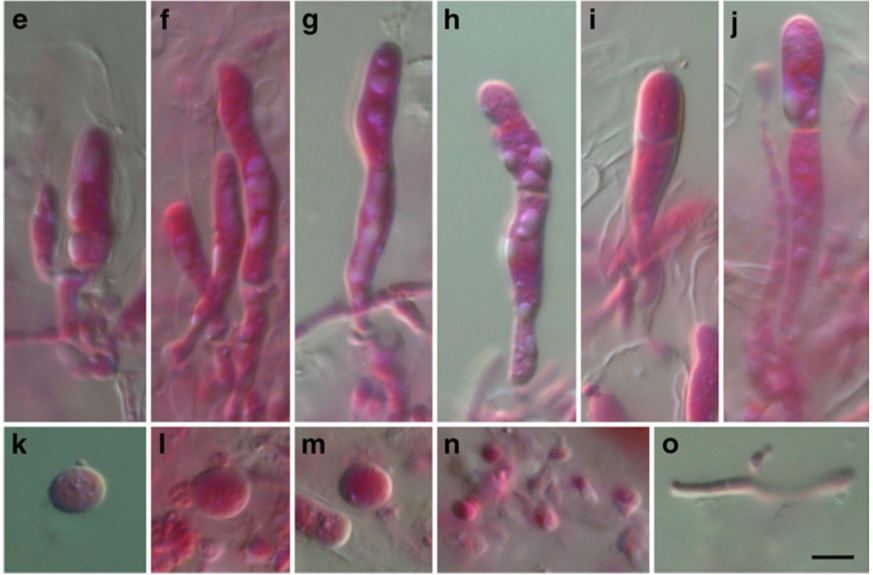Tremella graphidis Diederich, Millanes, Wedin & Common
Index Fungorum number: IF551495 Facesoffungi number: FoF01009
Etymology: In reference to the host Graphis. Holotype: Common 9434B (BR).
Lichenicolous in the hymenium of Graphis species, incl. G. assimilis, G. caesiella, G. cupei and G. cf. desquamescens, not gall-inducing, distinctly enlarging the width of the host ascomata and gradually replacing the host hymenium by the basidiomata. Known only from Florida. Sexual morph: Basidiomata developing within the host hymenium, strongly enlarging the width of the initially narrowly lirelliform host apothecia, pale pinkish to brown, strongly gelatinous, surface rather smooth, elongate, up to 2(−3)×0.25 mm (i.e., the same form and size as the broadened disk of the host apothecia). Context hyphae thin-walled, 1.5–2.5 μm diam., clamp connections not observed; haustorial branches present, mother cells subsphaerical, 2.5–3.5 μm long,1.5–2.5 μm wide, haustorial filament 1.5–4 μm long, 0.5–1 μm thick. Hymenium hyaline, containing numerous probasidia; hyphidia absent; probasidial initials narrowly clavate cylindrical, proliferations occurring through the basal clamp. Basidia, when mature, narrowly and elongate cylindrical, 2-celled, with one transverse septum in the upper third or quarter, not or slightly constricted at the septum, 30–38×4–5(−5.5) μm (excl. epibasidia), Q=6–8.5, without a stalk-like base; epibasidia subcylindrical, reaching at least 40 μm in length, probably 2–3 μm diam. (only old collapsed epibasidia observed). Basidiospores broadly ellipsoid, with a distinct apiculus, 6.3–6.8×5.3–5.8 μm, Q=1.1–1.2. Asexual morph: Undetermined.
Material examined: USA, Florida, Collier Co., Fakahatchee Strand State Preserve, trail north of Boardwalk, 25°56.51′ N, 81°28.16′ W, on Graphis assimilis and G. caesiella, 11 November 2011, R. Common 9434B (BR, holotype), (S, herb. Diederich, isotypes); ibid., on G. cf. desquamescens, R. Common 9443F (herb. Diederich); ibid., trail from Gate 7, 25°58.78′ N, 81°24.61′ W, on Graphis sp., R. Common 9370F (herb. Diederich); ibid., on G. caesiella, R. Common 9370H (herb. Diederich); near lake by Ranger Station, 25°57.25′ N, 81°21.80′ W, on G. caesiella, R. Common 9393H (herb. Diederich); ibid., Janes Scenic Drive, 25°58.74′ N, 81°22.26′ W, on G. cupei, 2014, R. Common 9736D, 9755J, 9763B, 9788C (herb. Diederich).
Notes: Tremella graphidis is a very distinct species, distinguished from all hitherto known lichenicolous Tremella species by the particularly long and narrow basidia, with a single transverse septum in the upper third or quarter. It mostly resembles Biatoropsis usnearum Räsänen s. lat., an assemblage of closely related species belonging to the non-monophyletic genus Tremella s. lat. (Millanesetal. 2014),andwhichhas1– 3-septate, clavate to subcylindrical basidia, 20–44×3–6.5μm, with usually missing basal clamps, and basidiospores 4.5–8× 4–7.5 μm. All intrahymenial Tremella species described by Diederich (1996) have broader basidia. Tremella graphidis is rather common in the hymenium of Graphis species in Fakahatchee Strand State Preserve in Florida, and resembles macroscopically Tremella phaeographinae Diederich & Aptroot, a species probably confined to Phaeographis s. lat., which is also common in Florida. The original material of T. phaeographinae was described from specimens of Phaeographina, a genus no longer recognized. The host of the holotype (Aptroot 26229, B) may belong in Platygramme, whilst the host of a paratype (Buck22971,NY) is Platygramme pachnodes (det. Lendemer & Tripp). The host of a further specimen (Harris 36016, NY) is Leiorreuma explicans (det. Lendemer & Tripp). Both Leiorreuma and Platygramme belongto the Phaeographis clade,which might represent a single large genus Phaeographis (RivasPlataetal. 2013), but none of the known host species has yet been included in a phylogenetic analysis. R. Harrisand H. Sipmanare acknowledged for information on the hosts identity. Tremella phaeographinae is macroscopically rather similar to T. graphidis, with basidiomata occurring on the host thallus and hymenium, but differs microscopically by very different, usually 3-celled basidia, often with a mixture of transverse and longitudinal septa. Tremella phaeographinae is here for the first time included in a phylogenetic analysis. Our results show that the Tremella species on Graphidaceae for which DNA sequences are available (i.e., T. diploschistina, T. graphidis and T. phaeographinae), do not group together. Tremella phaeographinae forms a well-supported clade with T. ramalinae, another Tremella species that combine both transverse and longitudinal septa within the same basidium (Diederich 1996).
Sequenced specimens of Tremella phaeographinae examined: USA, Florida, Hillsborough Co., Hillsborough River State Park, Florida Trail, 28°08.94′ N, 82°14.10′ W, on Phaeographis, 15 September 2011, R. Common 9481B (S,herb.Diederich);sequence‘a’; ibid.,28°08.90′ N,82°14.01′ W,on Phaeographis, 26 October 2011, R.Common 9249C (S, herb. Diederich); sequence ‘b’.

Tremella graphidis (BR, holotype) a, b Brownish basidiomata parasitizing the hymenium of Graphis assimilis (top left of a visibly non-infected part of host apothecia). c Hymenium with basidia d Context hyphae e, f Probasidia (basal clamp visible in d) g–j Mature 1-septate basidia k–m Basidiospores n–o Haustoria. All microscopical photos in Phloxin BusingDICoptics.Scalebars:a– b=200μm, c–d=10μm, e–o= 5 μm (scale bar ino). Photographs by P. Diederich

